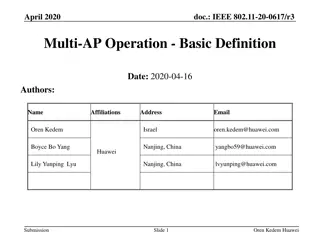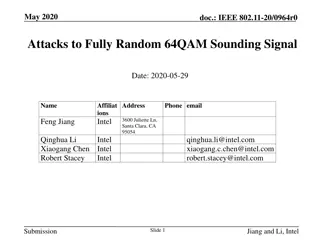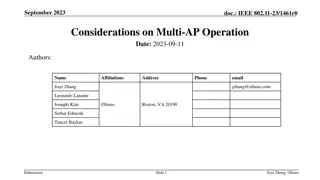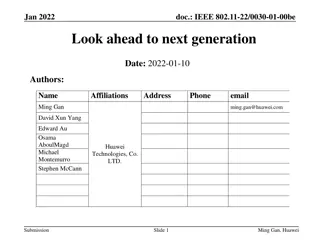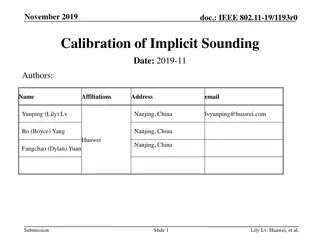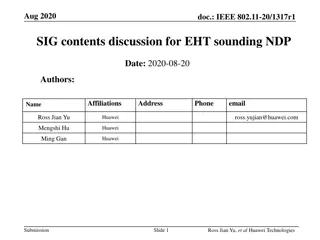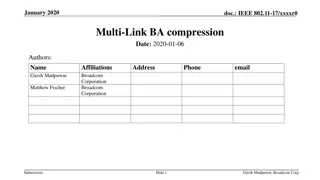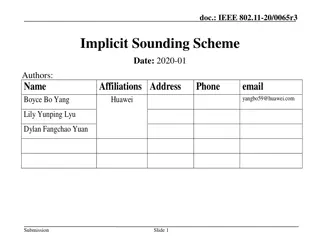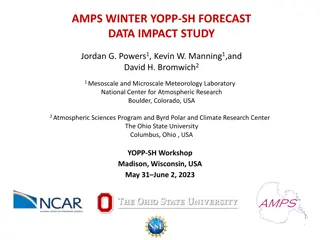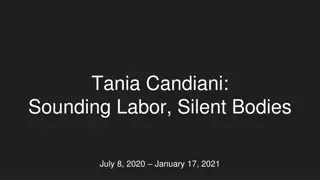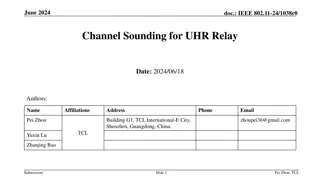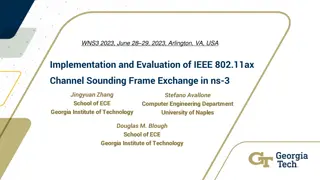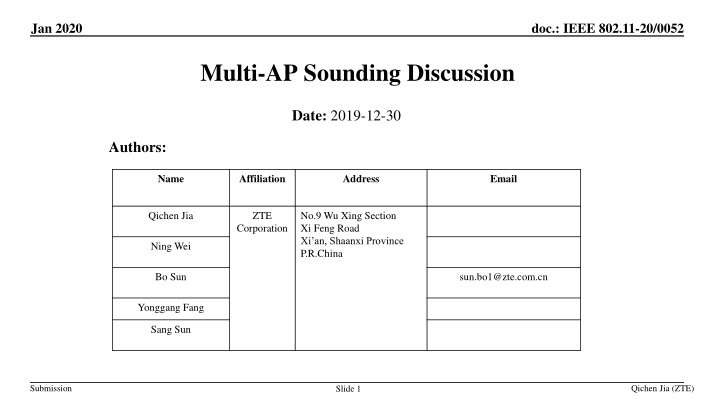
Enhancing Multi-AP Sounding Efficiency in Wireless Networks
Explore the significance of channel state information in multi-AP transmissions and the impact of different sounding approaches. Discover the challenges of sequential and joint sounding methods and a new proposal for code-based joint sounding. Learn how code division methods optimize channel estimation in UL MU-MIMO scenarios for improved performance.
Download Presentation

Please find below an Image/Link to download the presentation.
The content on the website is provided AS IS for your information and personal use only. It may not be sold, licensed, or shared on other websites without obtaining consent from the author. If you encounter any issues during the download, it is possible that the publisher has removed the file from their server.
You are allowed to download the files provided on this website for personal or commercial use, subject to the condition that they are used lawfully. All files are the property of their respective owners.
The content on the website is provided AS IS for your information and personal use only. It may not be sold, licensed, or shared on other websites without obtaining consent from the author.
E N D
Presentation Transcript
Jan 2020 doc.: IEEE 802.11-20/0052 Multi-AP Sounding Discussion Date: 2019-12-30 Authors: Name Affiliation Address Email Qichen Jia ZTE No.9 Wu Xing Section Xi Feng Road Xi an, Shaanxi Province P.R.China Corporation Ning Wei Bo Sun sun.bo1@zte.com.cn Yonggang Fang Sang Sun Submission Qichen Jia (ZTE) Slide 1
Jan 2020 doc.: IEEE 802.11-20/0052 Introduction (1) Channel state information (CSI) provided by channel sounding is critical in joint and coordinated multi-AP transmissions. The multi-AP sounding procedure should be preceded before the multi-AP transmissions. The multi-AP sounding may impact on the performance of multi-AP transmissions. Multi-AP sounding category [1-3] describe some channel sounding mechanisms for multi-AP transmission, in which the potential multi-AP sounding approaches can be categorized as a sequential or a joint sounding procedure. Multi-AP sequential sounding In this approach, an NDP sounding frame is sent sequentially by each AP of the multiple APs in the collaborated Multi-AP transmission. The sequential multi-AP sounding may utilize the existing single-AP sounding procedure without any change. However, this approach may have some major issues: The total time required by the multi-AP sequential sounding is proportional to the number of single-AP sounding. This may cause a latency concern in the multi-AP transmission. It may cause an issue of efficiency in the channel utilization as the sequential NDP sounding frame transmissions take longer time of channel occupancy. Submission Qichen Jia (ZTE) Slide 2
Jan 2020 doc.: IEEE 802.11-20/0052 Introduction (2) Multi-AP sounding category (continued) Multi-AP joint sounding In a multi-AP joint sounding approach, NDP sounding frames are transmitted simultaneously by multiple APs in the collaboration. Therefore it can reduce the number of NDP transmissions in sounding procedure, which in turn reduces the time of sounding procedure comparing to the multi-AP sequential sounding and improves the efficiency of channel utilization. However, in the tone selection based multi-AP joint sounding [1], the NDP sounding signal transmitted by each AP is only on the selected tones. Therefore each AP may not have get the CSI result on the entire bandwidth. In the full bandwidth multi-AP joint sounding [1, 2], on the other hand, the NDP sounding signal transmitted by each AP occupies the entire channel bandwidth. But this approach requires a large number of LTF symbols in the NDP frame, which increases the length of NDP signal and generates a high dimension of P matrix causing the complexity in the computation of CSI. The number of LTF symbols depends on the number of all antennas in the multi-AP participating the joint sounding procedure. Submission Qichen Jia (ZTE) Slide 3
Jan 2020 doc.: IEEE 802.11-20/0052 A Proposal of New Multi-AP Joint Sounding Code based multi-AP joint sounding Code division method has been adopted for channel-estimation in UL MU-MIMO. Each involved STA is assigned to an orthogonal LTF sequence to distinguish with other STAs in the UL MU- MIMO transmission. The new multi-AP code based joint sounding procedure An AP transmits a frame (e.g. Trigger) to other APs to initiate the multi-AP joint sounding procedure. All sounding APs send an MAP-NDPA + MAP-NDP simultaneously. A MAP-NDP sounding frame consists of a EHT-LTF sequence generated by the orthogonal sequence. Coordinating AP Trigger MAP-NDPA MAP-Joint NDP Coordinated AP MAP-Joint NDP MAP-NDPA Coordinated AP time Submission Qichen Jia (ZTE) Slide 4
Jan 2020 doc.: IEEE 802.11-20/0052 A Proposal of New Multi-AP Joint Sounding Code based multi-AP joint sounding EHT-LTF sequence generation The EHT-LTF sequence is carried in a MAP-NDP sounding frame. An orthogonal sequence from P matrix is assigned to an AP in the multi-AP joint sounding to generate its EHT-LTF. The dimension of orthogonal matrix should be larger than or equal to the number of APs in the joint sounding. An example of orthogonal matrix is [1 -1 1 1, 1 1 -1 1, 1 1 1 -1, -1 1 1 1], the orthogonal sequences assigned to APs: AP1 = [1 -1 1 1 ], AP2 = [1 1 -1 1], AP3 = [1 1 1 -1] and AP4 = [-1 1 1 1]. An AP creates its EHT-LTF sequence via multiplying the LTF sequence by its assigned orthogonal sequence. For example, EHT-LTF is generated by LTF (e.g. used in 11ax) multiplied by an orthogonal sequence. LTF (e.g. 11ax) Orthogonal sequence EHT-LTF sequence Submission Qichen Jia (ZTE) Slide 5
Jan 2020 doc.: IEEE 802.11-20/0052 Simulation Setup Objectives This simulation intends to compare the performance of the new multi-AP joint sounding method to other multi-AP sounding approaches. Simulation setting 4 APs : each AP has 4 Tx antennas; 1 STA: the STA has 4 Rx antennas LTF Type : 1x LTF Channel bandwidth: 20MHz Channel mode: Channel mode D with Gaussian noise Residual CFO: [0Hz, 200Hz, 400Hz, 800Hz]. Perfect synchronization. Orthogonal matrix P: 1 1 - 1 1 1 1 1 1 - 1 - 1 1 1 1 1 - 1 1 Submission Qichen Jia (ZTE) Slide 6
Jan 2020 doc.: IEEE 802.11-20/0052 Simulation Results (1) Channel Estimation Performance the multi-AP code-based joint sounding and the multi-AP sequential sounding methods The MSE difference between the multi-AP CD sounding and the multi-AP sequential sounding is about 0.01 when RCFO equal to 0. Submission Qichen Jia (ZTE) Slide 7
Jan 2020 doc.: IEEE 802.11-20/0052 Simulation Results (2) Channel Estimation Performance the multi-AP code-based joint sounding and the multi-AP sequential sounding The MSE difference between the multi-AP code based joint sounding and the multi-AP sequential sounding is about 0.015 to 0.025 when RCFO is 200Hz, 400Hz and 800Hz. Submission Qichen Jia (ZTE) Slide 8
Jan 2020 doc.: IEEE 802.11-20/0052 Simulation Results (3) Channel Estimation Performance the multi-AP code-based joint sounding and the multi-AP tone-selection joint sounding The Channel Estimation Performance of code-based joint sounding method is close to that of tone- selection joint sounding method. Submission Qichen Jia (ZTE) Slide 9
Jan 2020 doc.: IEEE 802.11-20/0052 Summary of Multi-AP Sounding Methods Multi-AP Sequential Method Multi-AP Joint Sounding Methods Full bandwidth method Tone selection method Code based method Lower latency than the multi-AP sequential sounding method (less NDPA and preambles than one in the multi-AP sequential sounding method) Lower latency Similar latency to the multi-AP tone selection joint sounding method Latency Higher latency (less LTF symbols than one in the multi-AP full bandwidth method) Higher complexity than the multi- AP sequential method (the dimension of P matrix is greater than one in the multi-AP sequential sounding method ) Lower complexity (the dimension of P matrix is similar to the multi-AP sequential sounding method) Similar to the multi-AP tone selection sounding method Complexity Lower complexity Slightly worse than the multi-AP sequential method and similar to the multi-AP tone selection method Similar to the multi-AP sequential sounding method Slightly worse than the multi-AP sequential sounding method Performance Higher performance Submission Qichen Jia (ZTE) Slide 10
Jan 2020 doc.: IEEE 802.11-20/0052 Conclusion In this contribution, we investigate and simulated a new multi-AP joint sounding method which is based on an existing MU-MIMO HE-LTF Mode to generate EHT-LTF sequences for NDP sounding. Submission Qichen Jia (ZTE) Slide 11
Jan 2020 doc.: IEEE 802.11-20/0052 Reference [1] 11-19-0448-01-0eht-multi-ap-transmission-procedure [2] 11-19-1593-00-00be-joint-sounding-for-multi-ap-systems [3] 11-19-1535-00-00be-sounding-for-ap-collaboration [4] IEEE P802.11ax/D6.0 Submission Qichen Jia (ZTE) Slide 12

